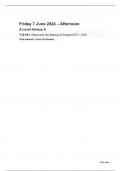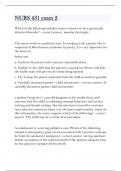-
1. Exam (elaborations) - Ocr a level history ay311/01 the origins and growth of the british empire 1558–1783...
-
2. Exam (elaborations) - Ocr a level history ay312/01 popular culture and the witchcraze of the 16th and17th c...
-
3. Exam (elaborations) - Ocr a level history ay313/01 the ascendancy of france 1610–1715 merged question pap...
-
4. Exam (elaborations) - Ocr a level history ay314/01 the challenge of german nationalism 1789–1919 merged q...
-
5. Exam (elaborations) - Ocr a level history ay315/01 the changing nature of warfare 1792–1945 merged questi...
-
6. Exam (elaborations) - Ocr a level history ay316/01britain and ireland 1791–1921 merged question paper and...
-
7. Exam (elaborations) - Ocr a level history ay317/01 china and its rulers 1839–1989 merged question paper a...
-
8. Exam (elaborations) - Ocr a level history ay318/01 russia and its rulers 1855–1964 merged question paper ...
-
9. Exam (elaborations) - Ocr a level history ay319/01 civil rights in the usa 1865–1992 merged question pape...
-
10. Exam (elaborations) - Ocr a level history ay320/01 from colonialism to independence:the british empire 185...
-
11. Exam (elaborations) - Ocr a level history ay321/01 the middle east 1908–2011: ottomans to arab spring mer...
-
12. Exam (elaborations) - Ocr a level history ay201/01 the rise of islam c.550–750 merged question paper and ...
-
13. Exam (elaborations) - Ocr a level history ay202/01 charlemagne 768–814 merged question paper and mark sch...
-
14. Exam (elaborations) - Ocr a level history ay203/01 the crusades and the crusader states 1095 –1192 mer...
-
15. Exam (elaborations) - Ocr a level history ay204/01 genghis khan and the explosion from the steppesc.1167–...
-
16. Exam (elaborations) - Ocr a level history ay205/01 exploration, encounters and empire 1445–1570 merged qu...
-
17. Exam (elaborations) - Ocr a level history ay206/01 spain 1469–1556 merged question paper and mark scheme ...
-
18. Exam (elaborations) - Ocr a level history ay207/01 the german reformation and the rule of charles v1500–1...
-
19. Exam (elaborations) - Ocr a level history ay208/01 philip ii 1556–1598 merged question paper and mark sch...
-
20. Exam (elaborations) - Ocr a level history ay209/01 african kingdoms c.1400–c.1800: four case studies merg...
-
21. Exam (elaborations) - Ocr a level history ay210/01 russia 1645–1741 merged question paper and mark scheme...
-
22. Exam (elaborations) - Ocr a level history ay212/01 the american revolution 1740–1796 merged question pape...
-
23. Exam (elaborations) - Ocr a level history ay213/01 the french revolution and the rule of napoleon1774–181...
-
24. Exam (elaborations) - Ocr a level history ay214/01 france 1814–1870 merged question paper and mark scheme...
-
25. Exam (elaborations) - Ocr a level history ay215/01 italy and unification 1789–1896 merged question paper ...
-
26. Exam (elaborations) - Ocr a level history ay216/01 the usa in the 19th century: westward expansion andcivil...
-
27. Exam (elaborations) - Ocr a level history ay217/01japan 1853–1937 merged question paper and mark scheme f...
-
28. Exam (elaborations) - Ocr a level history ay218/01 international relations 1890–1941 merged question pape...
-
29. Exam (elaborations) - Ocr a level history ay219/01 russia 1894–1941 merged question paper and mark scheme...
-
30. Exam (elaborations) - Ocr a level history ay220/01 italy 1896–1943 merged questions and mark scheme for j...
-
31. Exam (elaborations) - Ocr a level history ay222/01 the cold war in asia 1945–1993 merged question paper a...
-
32. Exam (elaborations) - Ocr a level history ay101/01 alfred and the making of england 871–1016 merged quest...
-
33. Exam (elaborations) - Ocr a level history ay102/01 anglo-saxon england and the norman conquest1035–1107 m...
-
34. Exam (elaborations) - Ocr a level history ay103/01 england 1199–1272 merged question paper and mark schem...
-
35. Exam (elaborations) - Ocr a level history a y104/01 england 1377-1455 merged question paper and mark scheme...
-
36. Exam (elaborations) - Ocr a level history ay105/01 england 1445–1509: lancastrians, yorkists and henry vi...
-
37. Exam (elaborations) - Ocr a level history ay106/01 england 1485–1558: the early tudors merged question pa...
-
38. Exam (elaborations) - Ocr a level history ay107/01 england 1547–1603: the later tudors merged question pa...
-
39. Exam (elaborations) -
-
40. Exam (elaborations) - Ocr a level history ay109/01 the making of georgian britain 1678–c.1760 merged ques...
-
41. Exam (elaborations) - Ocr a level history ay110/01 from pitt to peel 1783–1853 merged question paper and ...
-
42. Exam (elaborations) - Ocr a level history ay111/01 liberals, conservatives and the rise of labour1846–191...
-
43. Exam (elaborations) - Ocr a level history ay112/01 britain 1900–1951 merged question paper and mark schem...
-
44. Exam (elaborations) - Ocr a level history ay113/01 britain 1930–1997 merged question paper and mark schem...
-
45. Exam (elaborations) - Ocr as level history ay136/01 england 1485–1558: the early tudors merged question p...
-
46. Exam (elaborations) -
-
47. Exam (elaborations) - Ocr as level history ay143/01 britain 1930–1997 merged question paper and mark sche...
-
48. Exam (elaborations) - Ocr as level history ay137/01 england 1547–1603: the later tudors merged question p...
-
49. Exam (elaborations) - Ocr a level history ay223/01 the cold war in europe 1941–1995 merged question paper...
-
50. Exam (elaborations) - Ocr a level history ay224/01 apartheid and reconciliation: south african politics1948...
-
51. Exam (elaborations) - Ocr as level history ay243/01 the french revolution and the rule of napoleon1774–18...
-
52. Exam (elaborations) - Ocr as level history ay249/01russia 1894–1941 merged question paper and mark scheme...
-
53. Exam (elaborations) - Ocr as level history ay251/01 democracy and dictatorships in germany 1919–1963 merg...
-
54. Exam (elaborations) - Ocr as level history ay253/01 the cold war in europe 1941–1995 merged question pape...
-
55. Exam (elaborations) - Ocr a level history ay301/01 the early anglo‑saxons c.400–800 merged question pap...
-
56. Exam (elaborations) - Ocr a level history ay302/01 the viking age c.790–1066 merged question paper and ma...
-
57. Exam (elaborations) - Ocr a level history ay303/01 english government and the church 1066–1216 merged que...
-
58. Exam (elaborations) - Ocr a level history ay304/01 the church and medieval heresy c.1100–1437 merged ques...
-
59. Exam (elaborations) - Ocr a level history ay305/01the renaissance c.1400–c.1600 merged question paper and...
-
60. Exam (elaborations) - Ocr a level history ay306/01 rebellion and disorder under the tudors 1485–1603 merg...
-
61. Exam (elaborations) - Ocr a level history ay307/01 tudor foreign policy 1485–1603 merged question paper a...
-
62. Exam (elaborations) - Ocr a level history ay308/01 the catholic reformation 1492–1610 merged question pap...
-
63. Exam (elaborations) - Ocr a level history ay309/01 the ascendancy of the ottoman empire 1453–1606 merged ...
-
64. Exam (elaborations) - Ocr a level history ay310/01 the development of the nation state: france 1498–1610 ...
-
Show more





